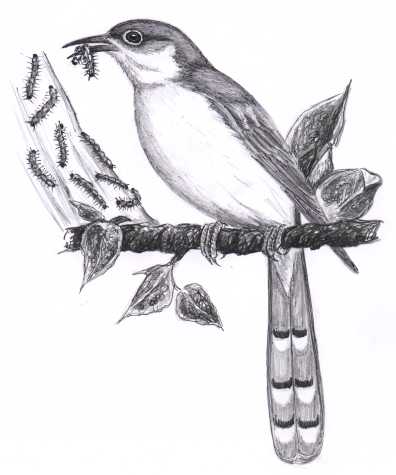
Dear Bird Folks,
I have an unusual bird in my South Orleans garden. We think it’s a cuckoo. Are cuckoos rare around here? Are they seasonal or with us year round?
– Jeff S., Orleans
No Jeff,
Cuckoos are not rare around here. Just go for a drive on Route 28 on any rainy summer day and you’ll find plenty of them. Actually, we have several kinds of cuckoos on the Cape. In addition to the aforementioned Route 28 cuckoos, we have both Yellow-billed Cuckoos and Black-billed Cuckoos. Even though the different species of cuckoos are very similar, they can easily be told apart by learning a few secret field marks. Not many people know about these field marks, so you may want to write this down. The Black-billed Cuckoos have black bills and the Yellow-billed Cuckoos have yellow bills. You got that? And, of course, the Route 28 cuckoos have Master Card bills.
There are several species of cuckoos worldwide. The old world cuckoos (the old world in this case is Europe, not Chatham) are parasitic nesters. They lay their eggs in other birds’ nests, much like our cowbirds do. The cuckoos from the Americas build their own nest and rarely lay eggs in the nest of another bird.
The new world cuckoos are totally handsome birds with long tails. And if you have these birds in your garden, you should consider yourself lucky, as they eat tons of nasty bugs. Cuckoos are one of the few birds that love hairy caterpillars. Most birds tend to look for those little bald caterpillars, but cuckoos go out of their way to eat the big hairy ones. One cuckoo was found to have as many as 350 caterpillars in it stomach, an accomplishment that is only rivaled by the number of french fries that can be held in a teenager’s stomach.
After eating so many big ugly caterpillars, a cuckoo’s stomach can become so matted with hair that its own digestion is obstructed. So what does the cuckoo do about this stomach full of matted har? (Warning: this next part is a little gross so you may want to send the kids out of the room before you read on.) To rid itself of a furry stomach, it is thought that the cuckoo sheds its own stomach lining and then grows a new one. Ish, can you imagine? Man, I wish I could have done that the last time I went to Mexico.
If cuckoos eat so many gross caterpillars, why don’t they stop the outbreaks of gypsy moths? Well, I’m sure they help the best they can, but it’s a bit like garden tomatoes in August, no matter how many are eaten, they just keep coming until the frost hits.
There seems to be a difference of opinion on how well the overall population of cuckoos is doing. Many think that the numbers are declining due to habitat destruction, while others seem to think that it is difficult to gauge as the populations rise and fall with caterpillar outbreaks. One thing is clear, cuckoos, like so many other birds, are directly affected when pesticides are used. Unlike feeder birds, there is little we can do to attract cuckoos to our property, but keeping poisons off your trees and gardens would be a good place to start.
Being insect lovers, cuckoos are forced to head south when the weather turns frosty. Some of them fly as far south as central Argentina. Therefore, the answer to the second part of your question is no, Black-billed and Yellow-billed cuckoos are not here year round. However, the route 28 cuckoos are alway here. Their population definitely grows in the summer but they are not all that hard to find in the winter either.